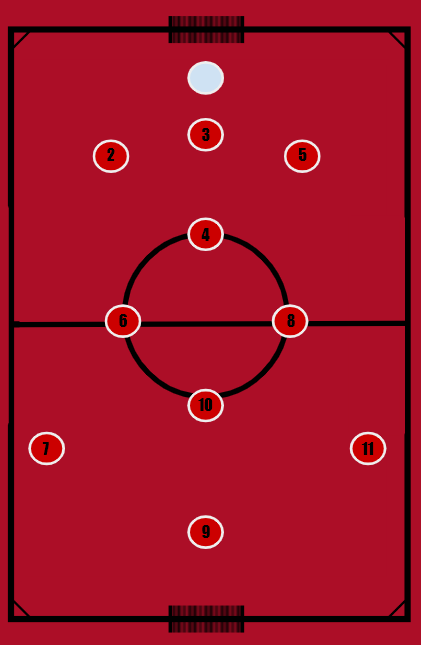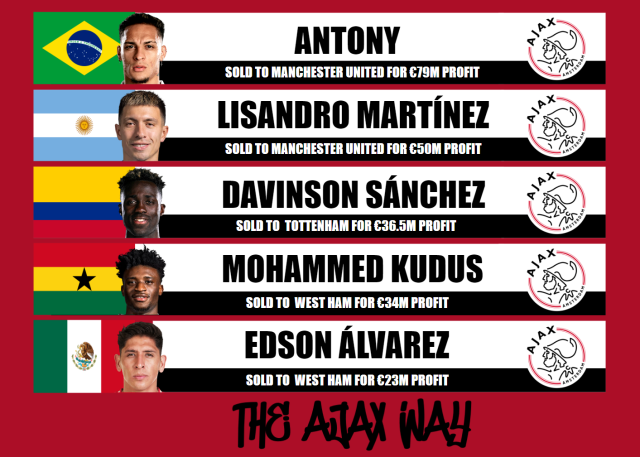
Given my love for developing talent from within…cue the shameless plug of my blog which featured in ‘The Byline’ called ‘How to nail Youth Development in FM23’. I wanted to choose a club for my FM24 save which would enable me to delve a little deeper into youth development and hopefully provide you, the reader with some more insightful content.
After weeks of carefully reading up on multiple clubs, I found myself stumble across the following articles ‘The academy spotlight: Ajax and Barcelona’ and ‘How a development model of promoting and selling early is keeping Ajax, PSV and Dortmund at the business end of the game’, both of which are published on These Football Times.
This led me down a very deep rabbit hole, thanks to the breadth and depth of available literature on AFC Ajax, which I will include some enjoyable pieces at the end of this blog.
The development of youth has been a fundamental pillar for the club, one which has also seen dividends for Dutch Football on the whole, given that at any given time, it is estimated that up to 35 footballers playing in the Eredivisie have received an education at Ajax’s academy.
For those of you who are SI Forum regulars, you will note that Cleon posted the topic ‘Ajax Youth Development – When The Real World Meets Football Manager’ which was his interpretation of the Ajax blueprint. This series ‘The Ajax Way’ will act as my very own attempt to delve into the core pillars which have been fundamental to clubs philosophy.
PLAYING PHILOSOPHY
The Ajax system is based on the Rinus Michels 70’s system of ‘Pressing Football’, where the team must press forward when in possession of the ball and press the opposition when the opposition is in possession of the ball. Louis van Gaal added his own philosophy to this style of play.

As you can see from the above attribute comparison, the current squad are not well aligned to this system, holding a natural fitness, and stamina average which sits only just above the Eredivisie average. I would expect Ajax to be in the top percentiles for both of these attributes, which I feel are key to playing the Ajax way.
The natural fitness attribute is a measure of how well a player can recover condition between matches, and avoid jadedness caused by matches and training. Whilst the stamina attribute is an indicator as to how well the squad can maintain condition while exerting effort during a match. The higher a players condition, the better he will perform any action.
Physical attributes essential for the Ajax way DNA: Natural Fitness, and Stamina
Ajax must also play captivating football as the essence of the game lies in entertaining the fans. Their style should be unique and easily identifiable, surpassing the prominence of their jerseys. Additionally, the club’s academy should be acknowledged as fundamental, with half the team comprising homegrown talents. These players must excel not only in Eredivisie but also on the grand stage of the Champions League.
The Ajax system is attack-oriented, prioritising forward passes. If not possible, sideways and then backward passes are preferred. The approach encourages 1 v 1 situations across the field, demanding strong technique against tight marking. Ajax players need superior individual skills compared to direct opponents.

Above I am looking to see how the squad compares to our opponents with regards to Passing, Technique and First Touch. Three fundamental attributes to playing the Ajax system. You will note that in these areas the current group of players excel, providing me the assurance that we should be well equipped to both playing the ball out of defence and take a patient approach in the final-third, by working the ball into the box.
Technical attributes essential for the Ajax way DNA: First Touch, Passing, and Technique
Finally, players must create space for themselves and teammates, moving after gaining possession. Defensively, upon losing possession, immediate pressing is crucial. The closest player to the ball engages the opponent, while others take covering positions to intercept passes.

When reading the above paragraph and thinking about player profiles, three things came into my mind. The need for ajax players to both be intelligent and consistent with regards to choice of action, Ajax players will need a strong mental profile.
There is still a need for a little ‘Je ne say qua’ which is where the flair attribute plays its role, I want players to have a natural talent for the creative and unpredictable, football should entertain.
Off the ball there is a need for individuals to be willing to work to their full capacity, going above and beyond the call of duty, hence the importance of work rate.
Mental attributes essential for the Ajax way DNA: Anticipation, Composure, Concentration, Decisions, Determination, Flair, Teamwork, Vision and Work Rate
DE TOEKOMST
De Toekomst was founded in 1900 and over the better part of a century it has produced players, coaches and a brand of football that has unlocked new layers and levels in the game.
The identity of the club is really important, Ajax are not a buying club, they are a club which focuses on producing young players. The youth academy (De Toekomst) is the base of the club, which when translated becomes apparent, as it means The Future.
‘We should only pay transfer fees for a player who is special, who very clearly fills up a gap in the team that an academy player cannot.‘
Without Ajax, it can be argued that Barcelona’s football factory, known as La Masia, may not have the attacking football culture and systemic set-up that has produced some of the best players in modern football. Indeed, the source of the Barcelona model is credited largely to Johan Cruyff and Rinus Michels. Ajax are synonymous with development of young and complete footballers from a technical and tactical perspective.
De Toekomst has played an integral role in providing a constant supply of talent to the senior team, this is reflected in the clubs average age of 22.6 years, making them the youngest club in the Eredivisie.
At Ajax, technical ability is more important than raw power and athleticism, especially at young ages. The staff at Ajax, many of them former professionals themselves and products of the academy, assess each player and decide if they fit the model and have the mentality to be tied to a youth contract.
Above are some fine examples of homegrown talent, products of De Toekomst, which have been sold on for significant fees. The academy at Ajax is special. There are few clubs, if any, that can boast such an influence on player development the world over and a roll call of stars that the Amsterdammers can. For this reason, ajax will always be synonymous with championing excellence in all things – and it starts with De Toekomst.
THE SYSTEM
The numbers on Ajax players’ shirts hold significance, denoting distinct positions and responsibilities. This system is consistent from youth to senior teams, fostering familiarity. Young players can easily identify their role models among the senior team based on shared positions.
A young player at the club will know which player in the first team plays in his position, and this senior player will be his role-model.
‘We want to get footballers to a higher level faster, so they don’t have to get used to the Eredivisie for two years. Players will receive individual training from a certain age. Every player needs to be treated differently.’
Every Ajax youth team is made up of a squad of 16 players, There are no additions to the squad during the season. The squad is :
2 – Goalkeepers.
4 – Right footed players for positions 2,6 and 7.
4 – Left footed players for positions 5,8 and 11.
3 – Players for positions 3 and 4.
3 – Players for positions 9 and 10.
This is something which I will endeavour to maintain across the save, ensuring there is a clear pathway for individuals and ensuring that sufficient game time is secured, a factor which we all know aids development.
The typical Ajax player in any age group has to show four basic principles in his profile as a footballer: technical actions, tactical principles, motor performance and mental skills, and these form the modern Ajax player.
I will be looking to use the Jong Ajax side, who play their trade in the Keuken Kampioen Divisie, the second tier of Dutch football, as my pathway into the first-team. One of my next posts will expand on how I decide if a player is ready to be integrated into the first-team squad, which I hope will be of value.
THE T.I.P.S. MODEL
Ajax demand four fundamental requirements from all the young players at the club, which is known as the T.I.P.S. model.
T-Technique is the number one requirement for an ajax player, all Ajax players must be technically good with the ball. The Ajax way is to play in the oppositions half of the pitch, this means players playing in tight space, which means that the player must be able to play using good technique.
I-Intelligence/Insight – Football intelligence is vital for the ajax style of play. Ajax players must be able to understand instructions and follow out these instructions. Ajax players must know what to do with the ball in given situations, such as when to hold on to the ball, and when to release the ball. They must know how to create space and when to move into space.
P-Personality is necessary for a team player. Players need strength of character and leadership qualities. The club looks for personality in players, to see if they are confident, if they can influence other players, and most importantly if they can work within a group. Ajax players must be able to gel with the other players in the team and not be an individual. The ajax team must be as one.
S-Speed of thought and speed of action is a characteristic of Ajax players. Ajax players must be able to sum up situations quickly to problem solve on the pitch.
You would have seen earlier in this blog a reference to different attributes which I feel are essential to playing the Ajax way, these have been selected to closely align to the T.I.P.S. model and will form the DNA criteria for this save. Of course not all of this model can be captured via the attributes as personality is determined by the seven personality attributes which are under the hood.
However, there are some key ways to interpret these attributes, through judging personality descriptions, media handling styles, coach reports, scout reports, reactions to team-talks, and body language during games.
RECRUITMENT PHILOSOPHY
Since 2016, in a process led by Marc Overmars, Ajax have broadened their horizons in terms of player recruitment, in a move which has seen them both scouted and recruit extensively from Latin and South America.
Globalisation has seen Ajax’s scouting network drastically improve, with Overmars making it clear that he wanted to have the best scouts he could find working with the club.
Above are some fine examples of how this additional pipeline of talent development has been of benefit to the club. These players have not only made key contributions for the club on the field, their sales have enabled Ajax to be sustainable, in a footballing landscape which has a large emphasis placed on the accounts off the field.
I will look to continue this recruitment strategy in my save. However, will only look to pay transfer fees for a player who is special, and who very clearly fills up a gap in the team that an academy player cannot.
TACTICAL VERSATILITY
Since the 1980’s Ajax have amassed a total of 17 Eredivisie titles, despite this dominance only three managers have been able to secure back-to-back-to-back trophies. Louis van Gaal (93/94, 94,95, and 95,96), Frank de Boer (10/11, 11/12, 12/13, and 13/14) and Erik ten Hag (18/19, 19/20, 20/21, and 21/22).
‘As you know, all good things come in threes, like Adidas’s three stripes and Ajax’s three championships in a row.’
The below images show the three different formations used by each manager. These will be the three different systems which fill my tactic slots on firing up the save.



Given that Ajax have a clear playing philosophy the in-game team instructions will be exactly the same across the three different systems. This will ensure that regardless of system the underlying principles of the Ajax way game model will stay consistent.
Each formation is a compromise of strengths and weaknesses. Therefore, I will be looking to react to opponents in-game, changing systems, and drawing upon every fibre of my tactical awareness with the view to making those all important marginal gains.
PROJECT 443-343
Prior to release, we were notified of the improvements to the match engine, providing the consumer with truer football motion, match authenticity, and positional play.
“Players now behave more intelligently, adjusting their position based on the roles and movement of teammates around them. Your players should have more passing lanes open to them and a better ability to play through the lines, allowing your team’s shape to dynamically adjust between different phases of attack.”
The improvements to positional play has fuelled an internal fire, I want to take De Boer’s 4-3-3 and make it morph into Van Gaal’s 3-4-3. Providing me with a tactic which is synonymous to the rich history of the club, and again enabling me to improve my understanding of the match engine and share with you, the reader.
SAVE OBJECTIVES
The first objective of the Ajax way will be to ensure that AFC Ajax are labelled as the undisputed number one team in the Netherlands, not just by winning the domestic title, but also by maintaining a strong financial position.
I want to enter the history books, joining the select list of managers that have been able to secure a three-peat of Eredivisie titles.
The second objective focuses on creating a dominant Ajax on the continent, one which can mix with Europe’s best by promoting players from within and shrewdly using the transfer market.
The third objective is to establish that Ajax have the best youth education in football at De Toekomst, furthering the greatness of their academy and giving more talents the chance to make their mark in the first team.
Ideally to achieve objectives two, and three, we will win the UEFA Champions League, with a team which is made up with a significant amount of players which have come through De Toekomst, ambassadors of the Amsterdam blueprint, the ‘Ajax Way’.
As well as the above in-game objectives, I hope that in following this topic, I will be able to provide you, the reader, with a greater understanding on the following areas of he game;
- Training
- Individual Training
- Player Development
- Mentoring
- Staff Recruitment
- Data Driven Player Recruitment
I hope you have enjoyed the opening post to the Ajax way, this save will be documented here on ‘View From The Touchline’ and also over on the SI Forum, where I will provide smaller updates, most likely snippets of my initial thoughts which will then feed into the main save updates.









Czekam z niecierpliwością.
Absolutely sensational reading man. This could well be some of your best work yet.
Thanks Chris, I am full of enthusiasm with regards to this save, I have a clear vision on what I want to achieve and am confident this save will go the distance.
This is something very close to what I was thinking of doing in FM24, I love reading such a detailed article, I will follow very carefully all the coming posts, great job!
Could you share your tactical formations?
Will be in future posts
I am new in FM and started with Ajax as a “easy” start. Would love to see the formations and tacs shared – are they working in the released version? Thanks for the article =)
They will be in future posts
This looks really brilliant, so much detail already and only the start, looking forward to the next part.
How do you plan to implement the TIPS training model? What type of schedules are you thinking about using?